What Types Of Water Plants And Animals Found In The Indian Ocean
Disclaimer: This postal service may contain affiliate links. All hosted affiliate links follow our editorial policies.
When near people think of Indian animals, the Imperial Bengal Tiger is usually the starting time species that springs to mind. And with expert reason: The subcontinent is home to more than one-half of the world'due south wild tigers, with a thriving population in nearly l tiger reserves.
Merely the national animal of Bharat is inappreciably the simply owned species of Indian wildlife. In fact, India is habitation to approximately vii.six% of the world's species of mammals, 12.6% of its bird species, and 6.2% of its reptiles.
Protected by more than 120 national parks, xviii Biosphere reserves, and 500+ wild fauna sanctuaries, the animals of India are vast and varied. It'southward the only land in the earth where you accept a relatively good run a risk of seeing (Asiatic) Lions, (Bengal and Indochinese) Tigers, and (Sloth) Bears.
Other iconic species of wild animals in India include Asian Elephants, Snow Leopards, Clouded Leopards, the Great Indian Rhino, Deer (including Barasingha, Chital, and Hangul), the Dhole (a.k.a. Indian Wild Domestic dog), and endemics such equally the Nigiri Leaf Monkey.
Before you travel to visit India, check out our guide to 40 incredible Indian wild fauna species, which includes many of the state'southward most fascinating noon predators, birds, mammals, and reptiles.
READ MORE: l Fascinating Facts About Indian Culture
WILD INDIAN ANIMALS
Click our printable Indian Animals List with Big Cats in India, Birds in India, Mammals in India, Indian Snakes, Indian Lizards and other Indian Wildlife.
- Large Cats in India
- Birds in Bharat
- Mammals in India
- Indian Snakes
- Indian Lizards
- Other Indian Reptiles
Big CATS IN India
Asiatic Lion
Although a majority of wild lions alive in Africa, India is dwelling house to the last population of Asiatic Lions. These Indian big cats alive in Gir Forest in Gujarat, located in western India. The Asiatic Lion is the state animal of Gujarat.
Like other lion species, Asiatic lions live in prides. But they're smaller than the African multifariousness, weighing effectually 300-500 lbs.
Asiatic Lions are also distinguished from their African counterparts by an actress fold of skin along their stomachs.
With a full population of around 500, these lions' slightly different features may exist a result of inbreeding.
But wild fauna conservation in India has helped grow the population to where many lions at present live outside the Gir Protected Area.
READ More than: The Walking With Lions & Canned Panthera leo Hunting Connectedness
Royal Bengal Tiger
Equally i of the five remaining species of tiger, Regal Bengal Tigers make upwards about half of all wild tigers.
Tigers are the largest big cats in Republic of india, and Bengals tin can weigh anywhere from 240-500 lbs. There are about 2500 of these tigers today, who can be plant in different types of forests .
They spend nigh of their time alone, hunting for medium-sized mammals in India such every bit deer and boars early in the forenoon or tardily in the evening while resting during the day.
Deforestation also equally poaching accept caused dramatic population declines for these tigers over the concluding few decades.
But conservation efforts are working toward strengthening Bengal tigers' environments and cracking down on poaching.
READ MORE: Ranthambore National Park- On The Trail Of Tigers
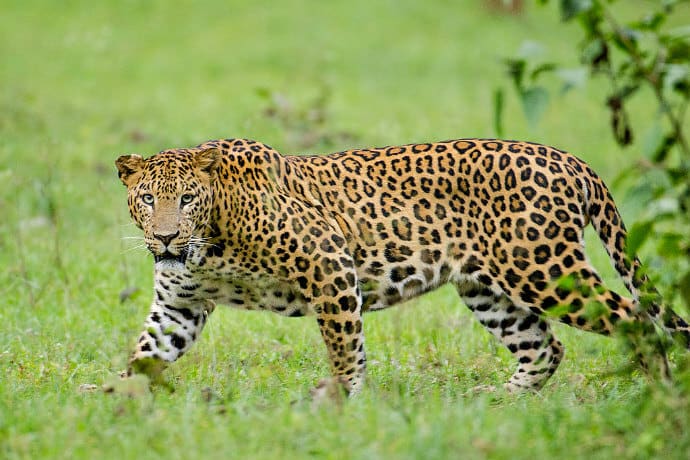
Indian Leopard
Primarily found in the trees, Indian Leopards are distinct from other leopards for their larger spots (or rosettes) and coat colors, which vary depending upon their habitat.
Rosettes, similar a tiger'south stripes, are distinct for each animate being, with no two sets existence exactly alike.
These leopards are solitary animals who leave the trees only to hunt for unlike varieties of deer and Sambar (state brute of Odisha) and Langur monkeys.
Their hunting fashion relies upon their strong jaw muscles. And, unlike other predators, they have been known to bring their prey into the trees with them.
Along with their treetop homes, Indian leopards are fond of pond and sunning themselves.
READ MORE: Saving Asian Animals (10 All-time Conservation NGOs)
Snow Leopard
With a thick, long coat, Snow Leopards are plant in the Himalayan mountains of North India. The Snow Leopard is the land beast of Himachal Pradesh.
These cats accept a light grayness coat to cover-up them in the snow and keep them warm in the cold.
Their big paws likewise keep them agile on the thick snowfall of the mountains. Since they live in the mountains, these solitary cats feed on dissimilar species of mountainous sheep.
These leopards are likewise distinct for their more passive nature, since they have not been observed to be aggressive to people.
This attitude is highlighted by their inability to roar due to the beefcake of their throats, which make them appear to be a less intimidating variety of leopard.
READ MORE: Endangered Species Spotlight: Snowfall Leopard
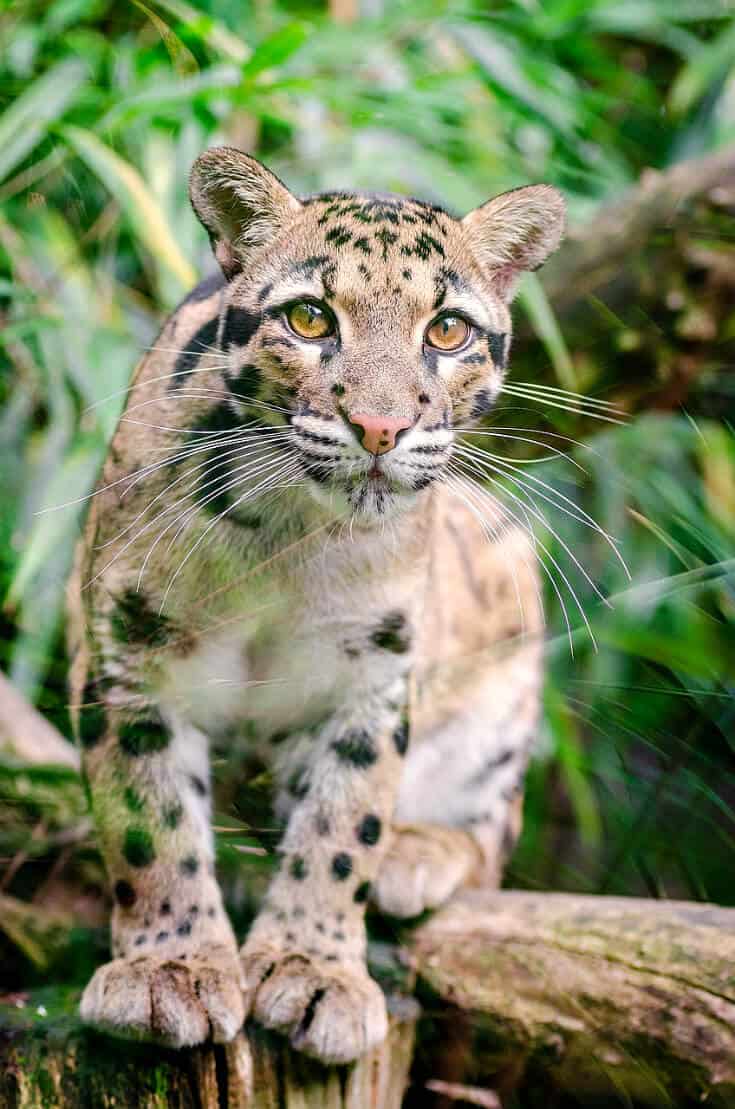
Overcast Leopard
Big spots, brusk legs, and a big head distinguish the Overcast Leopard from other leopard species. The Clouded Leopard is the state animal of Meghalaya.
Clouded Leopards come in two subspecies, one of which is found in the forests of southeastern Asia and the other institute on the islands of Borneo and Sumatra .
Like other leopards, they alive in trees and feed on mammals like monkeys. But their larger heads and teeth set them apart. Their short and powerful legs likewise aid these Indian animals in climbing and hunting.
These cats are also a fleck smaller than other leopards, weighing but up to 50 lbs. But they more than make up for it with their impressive strength.
The powerful Overcast Leopard has even been known to hang upside down from tree branches, making the most of their strong paws.
READ MORE: 60 Weird Animals Around The World
BIRDS IN INDIA
Indian Spotted Hawkeye
Residing in northern India, the Indian Spotted Eagle has brown feathers with lighter spots that give the bird its name.
These birds of prey alive in forests, where they hunt for mammals, amphibians, and smaller birds.
Their coloring is lighter than other species of spotted eagles. They also stand out from other spotted eagles due to their mouths and optics. The Indian Spotted Hawkeye's mouth is the widest of its related species, and its optics are darker than others.
This hawkeye has a bizarre telephone call that is commonly described as a high-pitched cackling audio. And they prefer to reside in woods areas rather than wetlands, which are preferred by their sis species the Greater Spotted Eagle.
READ More than: 15 Beautiful Birds Of The Galapagos Islands
Golden Hawkeye
A golden neck and back stand out against the nighttime brownish trunk of the Golden Eagle.
This beautiful bird is found in open up areas, particularly the Himalayas. There information technology feeds on modest mammals such as rabbits and rodents, as well every bit smaller birds in India.
Gilt Eagles are great hunters: Large eyes provide these birds with excellent eyesight during the day, which helps with finding prey from long distances.
They also hunt in pairs, tag-teaming their prey, with ane hawkeye directing prey to the other. Pairs are a serious delivery for the Golden Eagle, since they mate for life and take several nests and chicks together over their lifetimes.
READ MORE: How To Feel Traditional Mongolian Culture
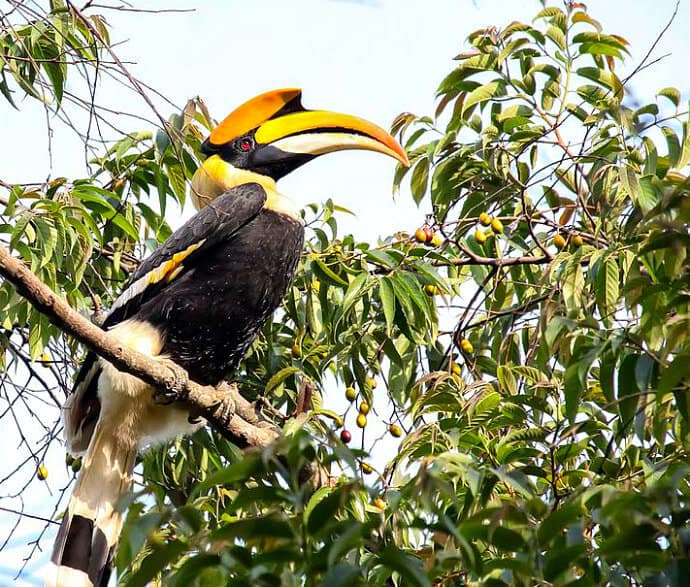
Slap-up Indian Hornbill
The Great Indian Hornbill is hands identifiable by a vivid yellow feature resembling a horizontal banana.
This feature, called a casque, sits on the bird'south upper nib, only has not been observed to serve a specific role in the bird'due south behavior.
They feed on fruit (which likewise provides them with all the h2o they need), forth with pocket-size mammals and other pocket-size birds.
Using their bright xanthous bills, the Slap-up Indian Hornbill eats its prey in an unusual way: It throws it into the air after capturing it, and then swallows information technology whole.
In India, the bird is constitute in the Himalayas equally well as the Western Ghats.
READ More : Tibetan Culture In Ladakh, India
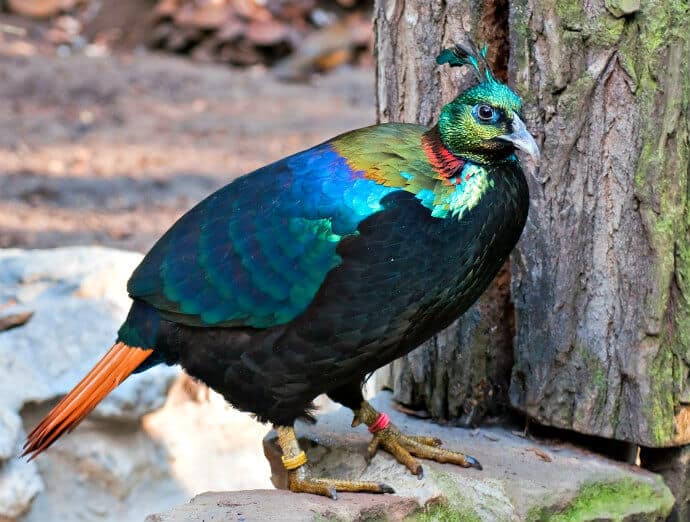
Himalayan Monal
Also known as the Impeyan Pheasant, the Himalayan Monal resides in the earth-renowned mountains in North Republic of india.
Much similar peacocks, the males accept brilliant plumage, with feathers in varying shades of blueish, green, red, and purple. This led to the species' nickname, "the nine-colored bird."
Female person Himalayan Monals, on the other manus, are a low-cal brown color with black feathers interspersed, similar to female peacocks.
These birds use their bills to feed on insects by digging them out of the footing. Due to their environs existence cold and mountainous, the Himalayan Monal is well-equipped to dig in the snowfall when scavenging for food.
READ MORE: 10 All-time Mountains in the World (World Travel Bucket List)
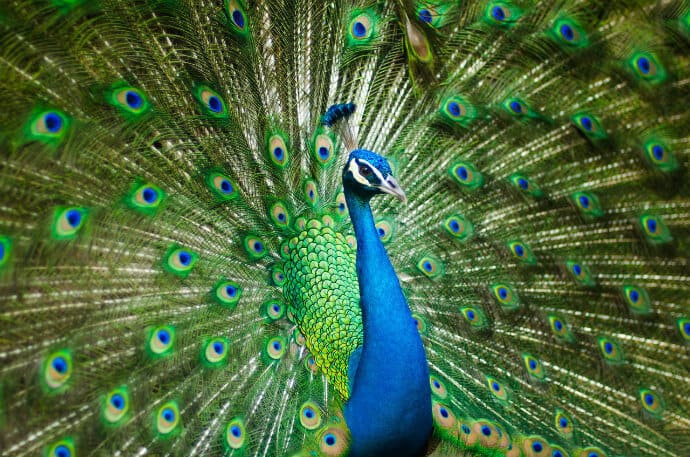
Indian Peafowl
The Indian Peafowl is one of the most striking birds in the world and is the Indian national bird.
Male Peacocks are notable for their glorious blue and dark-green feathers, also as the distinctive mating trip the light fantastic toe they use to woo females.
Female person Peahens are brown in color, and males apply their vivid coloring to attract the more than modest-looking females.
The Peacock'due south long, distinguishable feathers are oft chosen a tail, but they are actually a "train" made of feathers covering the base of the tail (called coverts).
Although males are flashy in appearance, they are able to evade predators who grab onto their feathers past flying abroad, with the feather detaching from its body easily.
READ More :Salman Rushdie on Republic of india'due south Struggle for Independence
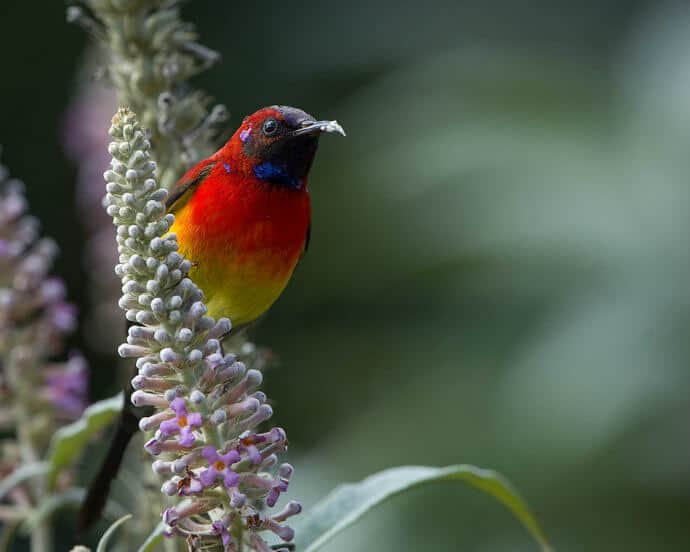
Mrs. Gould's Sunbird
Named for Elizabeth Gould, the wife of noteworthy English language ornithologist John Gould, Mrs. Gould'south Sunbirds are known for their colorful beauty.
These vivid birds have all the primary colors deemed for, with red backs, yellow stomachs, and a small-scale blue patch on the face. They feed on insects and nectar and reside in tropical woods habitats.
Mrs. Gould's Sunbirds are more than easily found in eastern and southeastern Asia, in countries like Kingdom of bhutan and Nepal . They're adequately uncommon in Republic of india, but they have been spotted in the eastern part of the country.
Thankfully, these pretty birds take a stable population, and are of least concern in terms of conservation condition.
READ MORE : x Steps To Bhutan Happiness: A Nature Lover's Travel Guide
Oriental Dwarf Kingfisher
Although it is small-scale in size, the Oriental Dwarf Kingfisher is a proficient predator that should not exist messed with.
These birds measure out simply thirteen cm (5 inches) in length. Yet they feed on a variety of pocket-size amphibians and reptiles past hovering over bodies of h2o and chop-chop diving after their prey.
Water sources are important for this bird, as they similar to live near small streams in the wood.
The Oriental Dwarf Kingfisher is also noteworthy for its vivid orange beak and feet along with multicolored feathers of yellow, orange, blue, and pink.
They are aptly known as the 3-toed Kingfisher for the presence of three toes on each foot.
READ More: 10 Nigh Important Rivers in The World
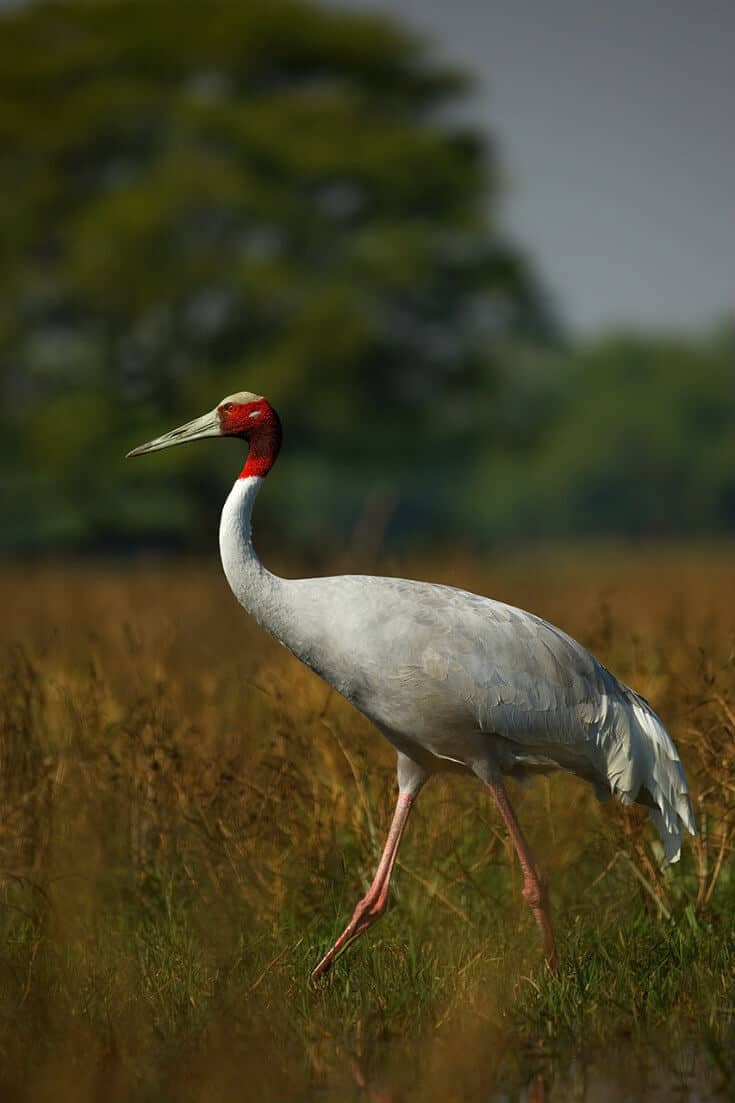
Sarus Crane
Found in northern and central India, the Sarus Crane is the tallest flying bird in the world (at a elevation that can range up to 5 feet 11 inches).
These alpine birds stand out, not only for their height, but their red heads and legs set against gray bodies.
Sarus Cranes live in pocket-sized groups in the wetlands areas of northwestern India. They feed on plants and insects near the water, including in agricultural areas.
Out of all the globe'due south crane species, the Sarus Crane is arguably the to the lowest degree social. They're known to be territorial and, at times, aggressive.
MAMMALS IN INDIA
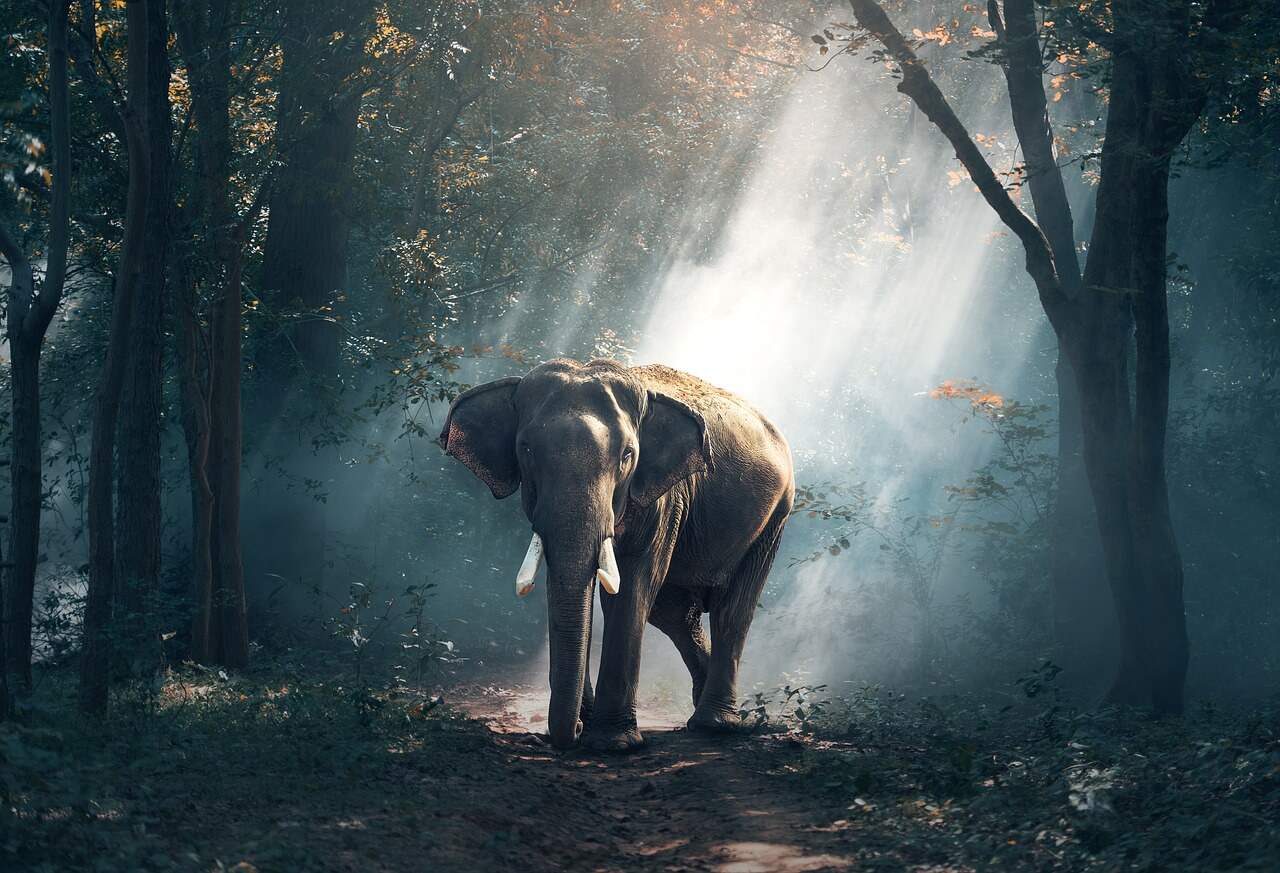
Asian Elephant
One of 2 species of elephants in the globe, the Asian Elephant is the slightly smaller counterpart of the African Elephant. Their ears are smaller and rounder than the African elephant's, and female (likewise as some male person) Asian elephants do not have tusks.
The Asian Elephant a.grand.a. Indian Elephant is the country animal of Karnataka, the country fauna of Kerala, and the state fauna of Jharkhand.
These elephants can usually be plant in forests and grassy areas. They communicate with each other over distances of upwards to 2 miles by making very depression rumbling sounds.
An especially noteworthy feature of elephants is their trunks, which have a finger-like attachment at the end that allows them to grip objects, drink water, and communicate.
With strong emotional ties rooted in Hinduism, Asian Elephants also take a huge significance in traditional Indian culture.
READ MORE: 50 Interesting Facts Well-nigh Elephants (for World Elephant Twenty-four hours)
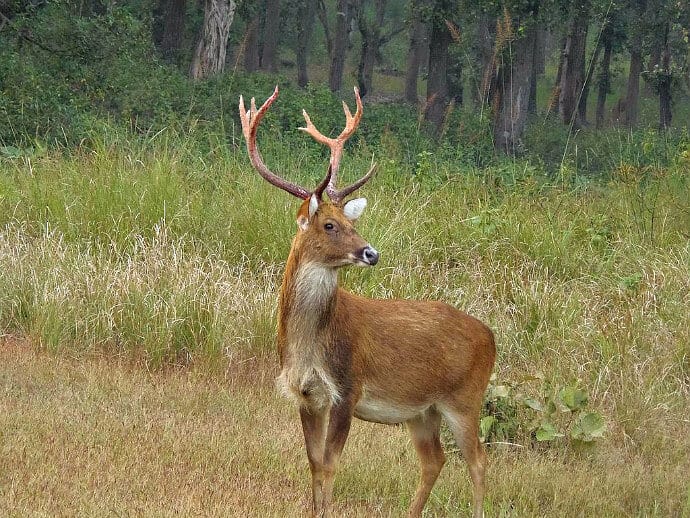
Barasingha Deer
With a proper name that translates as "12-tined," the Barasingha Deer is named for the presence of betwixt 12 and twenty tines on its antlers.
Living in northern and central India, the Barasingha Deer is the state fauna of Madhya Pradesh and the land animal of Uttar Pradesh. These deer accept gold coats, but tin can exist difficult to spot in the wild.
Barasingha Deer are besides referred to as swamp deer, since they usually alive along rivers and not in the open up wood.
Like other deer, the Barasingha grazes on grass and plants growing nigh the h2o throughout the twenty-four hour period.
Unfortunately, their preferred habitats are in trouble due to existence converted into agricultural country or deforestation. Merely they can be establish in several national parks in India.
READ MORE: Kanha National Park Tiger Reserve
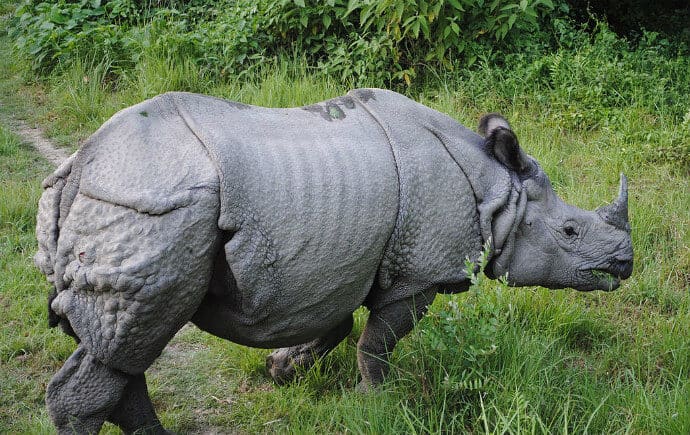
Indian Rhinoceros
Institute in northern India, the Indian Rhinoceros is besides known as the Greater One-horned Rhino for its atypical horn. It is the Assam state creature.
This horn is 8-25 inches long and blackness in color. The remainder of their bodies are grey, with layers of pare resembling armor.
Their skin is tough only flexible, which helps these large mammals move. Despite a weight of around 2.ii tons, these rhinos can run at a speed of up to thirty miles per hour when provoked.
Although they are big in size, these animals graze on grass, leaves, and fruit found throughout their homes in grassy areas and forests. Unfortunately, it is one of the most critically endangered Indian animals.
READ MORE: Killing For Conservation: Can Hunting Save The Black Rhinoceros?
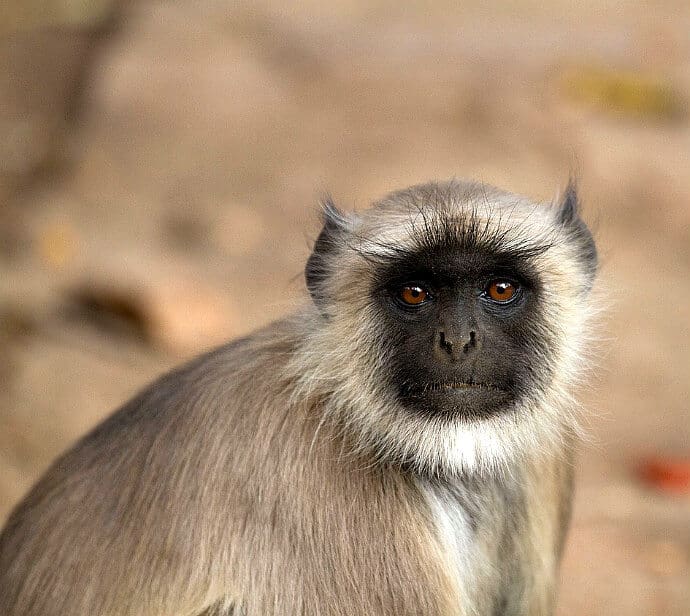
Langur Monkeys
Langur Monkeys come in several varieties, and can be found throughout southern and southeastern Asia. Phayre's langur is the country brute of Tripura.
They dine on leaves, fruit, and tree bark, and their circuitous stomachs and digestive systems cause these monkeys to have slight pot bellies.
Unlike many other monkeys, Langurs do not use their long tails to take hold of objects. But they are used for residuum and sometimes advice.
They spend near of their fourth dimension high in the trees and infrequently come downwards to the ground. When they practice, at least i monkey remains in the copse to watch out for potential predators (such as tigers) while the other monkeys are drinking water.
READ MORE: forty Amazing Costa Rican Animals

Himalayan Musk Deer
Found in the Himalayas, the Himalayan Musk Deer lives in the mountains. These deer are named for a musk sac, which is used for communicating with one another likewise equally attracting females.
Himalayan Musk Deer feed primarily on grass, moss, and other plants, and do not usually venture out very far to forage.
However, males are known to be quite territorial and aggressive with one some other.
Potent senses of smell and hearing help these deer lookout man out for each other and their respective homes. They will sometimes scream to alert other deer when they take been hurt.

King of beasts-tailed Macaque
Lion-tailed Macaques can just be plant living in rainforests in the Western Ghats of India. These monkeys have blackness fur all over their bodies, just their tails are blank except for a ball of pilus at the end that looks like a pom-pom.
Lion-tailed macaques rely heavily on spoken advice, and have 17 vocal patterns.
They are besides notable for their large cheeks, which can agree huge quantities of food (such equally fruit, flowers, and occasional lizards) in order to apace escape predators they encounter while foraging.
Their cheeks can store the same corporeality of nutrient every bit their stomachs, which makes for quite an interesting sight!
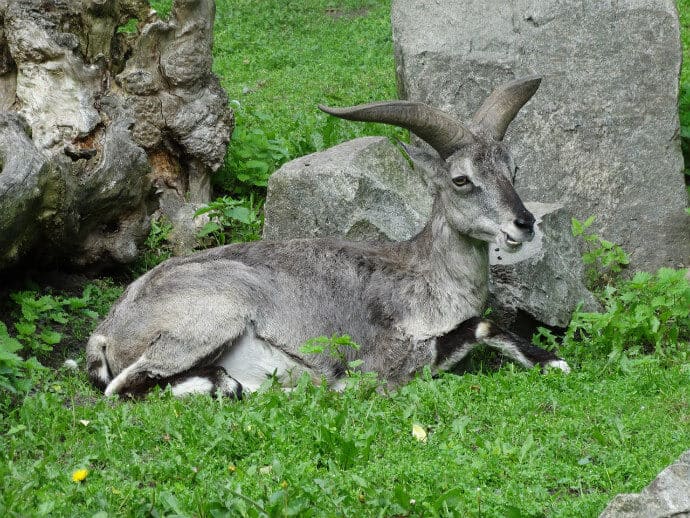
Bharal (Himalayan Blue Sheep)
Although they are technically sheep, Bharals await a lot more like goats. They are marked by large horns and a blue-gray coat of fur, rather than the typical white fur of the average sheep.
They are found in the Himalayas and can live in many different types of habitats, from hot mountains to common cold cliffs. Their blue-colored fur helps camouflage them in the mountains.
These sheep feed on different types of grass depending on the flavour, and they stay near cliffs in order to hands run abroad from predators.
One of their master predators is the Snow Leopard, making them a crucial part of the Himalayan ecosystem.
READ MORE: The Annapurna Excursion Expedition (Why It May Be At present or Never)
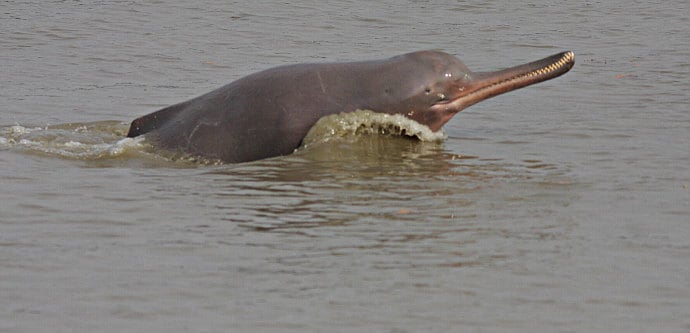
Ganges River Dolphin
Found in the sacred Ganges River, this river dolphin is the national aquatic creature of India and i of the oldest known species in existence. Unfortunately, it's as well among the most endangered Indian animals on this listing.
The Ganges River Dolphin is gray-chocolate-brown in color, with females having a longer snout than males, and may travel solo or in small groups.
Due to severe pollution of the Ganges River , these dolphins and their prey are endangered considering they inevitably ingest chemicals from all of the toxic substances in the h2o.
These dolphins only live in freshwater environments, and due to poor eyesight they swim on their sides and have stronger hearing skills.
They utilize echolocation for hunting, and they are carnivores who feed on fish as well as aquatic plants when necessary.
READ MORE: How to Grade Convict Dolphin Facilities
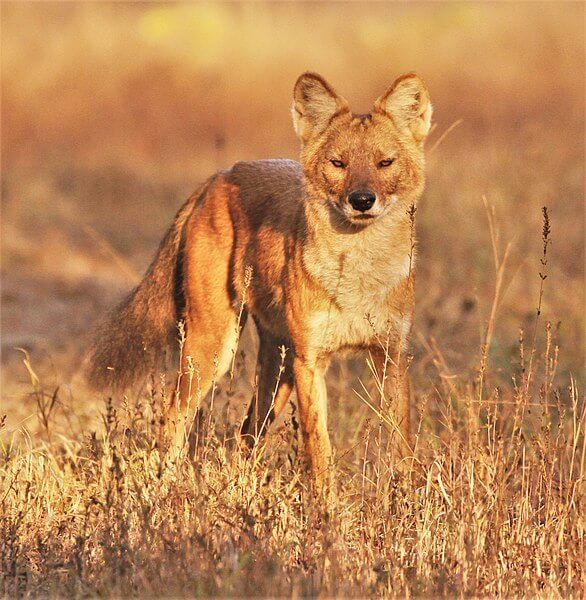
Dhole (Indian Wild Dog)
About the same size as a German language shepherd, Dholes are nonconformists in the world of dogs. With one less molar on each side of their mouths and a tail more than like that of a fox, Dholes stand out amongst other animals their size.
These Indian Wild Dogs are known for their speed on both land and water, which aids in their hunting of larger prey such as deer and buffalo.
These dogs are as well distinct for their advice style, which consists of whistles among the pack.
Since they are able to prey on much larger animals, the biggest threat to the Dhole is humans, habitat loss, and diseases from domesticated dogs. Fortunately, numerous conservation NGOs are working to save this rare Indian animals.
READ More than: Facts Nigh the Dhole (Indian Wild Dog)

Sloth Conduct
Identifiable past their black, shaggy coats, Sloth Bears tin be plant in the forests of India.
These noisy, lonely bears primarily feed on termites, ants, and fruit, using their paws and long claws to dig termites out of the footing.
Since they're missing their two front teeth, the bears swallow the termites past sucking them upwardly through the gap.
Sloth Bears are unusual for a few reasons: Unlike most other bears, they do not hibernate.
Their shaggy fur has a foreign purpose, every bit the extra hair on their backs is utilized for conveying young sloth bears until they are 6-9 months old. Sloth Bears are the only bears to comport their young this way.
READ More than: Top ten Things To Do In Agra, India (For Nature/History Lovers)

Indian Wolf
Sometimes mistaken for a play a trick on due to their pocket-sized size, the Indian Wolf tin can exist institute in open up areas of India. They counterbalance in around twoscore-60 lbs and measure well-nigh 2-three feet in length.
These wolves are distinct from other wolves for other reasons as well, including their infrequent howling, mating time in October, and short, dumbo coat of fur.
Their lack of howling is sometimes attributed to the wolves being less territorial than well-nigh wolf species, and their short fur is useful in the Indian wolf's warm environment.
These modest wolves feed on pocket-size mammals such as rabbits and rodents. Sadly, these beautiful Indian animals are increasingly endangered due to habitat loss and human conflict.
READ More than: v Species of Animals That Mate For Life
Indian Snakes
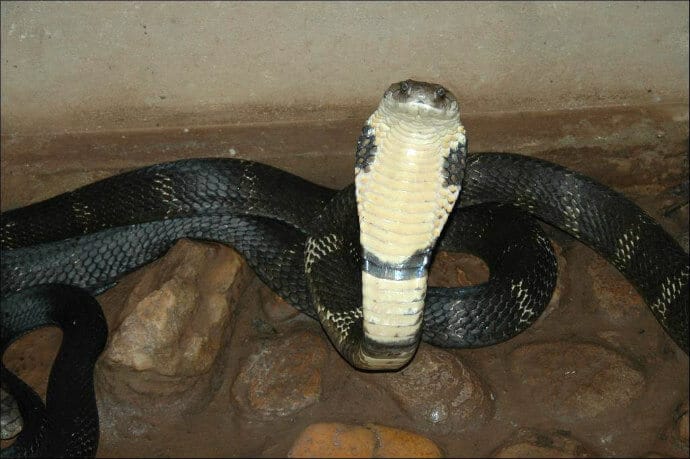
Giant King Cobra
1 of the most well-known snakes in the world, the Giant King Cobra is not technically fifty-fifty a cobra. These snakes are more closely related to the deadly Mambas found in northern Africa.
Regardless of their specific species, King Cobras are known for existence the longest venomous snakes in the world.
They can grow upwards to 10-xiii feet in length—twice every bit long as a person. Their venom targets the immune systems of its casualty, rather than the circulatory system.
Other unusual qualities include their nutrition (mostly other snakes) and nest-building. King Cobras are the only snakes in the globe who build nests in grooming for laying eggs.

Indian Cobra
With a distinctive design on its hood resembling a mouse or glasses, Indian Cobras are large Indian snakes that are found in well-nigh habitats other than deserts .
When nether threat, these snakes raise their hoods and stretch their necks upwards, showing off the hood marking.
These snakes feed on reptiles and rodents, always swallowing them whole, just too feed on other venomous snakes. Their venom is very potent, and tin paralyze or even kill their victims, including humans.
In search of food, Indian cobras sometimes wander into human-populated areas such as farms, villages, or fifty-fifty buildings. This can occasionally lead to humans existence bitten.
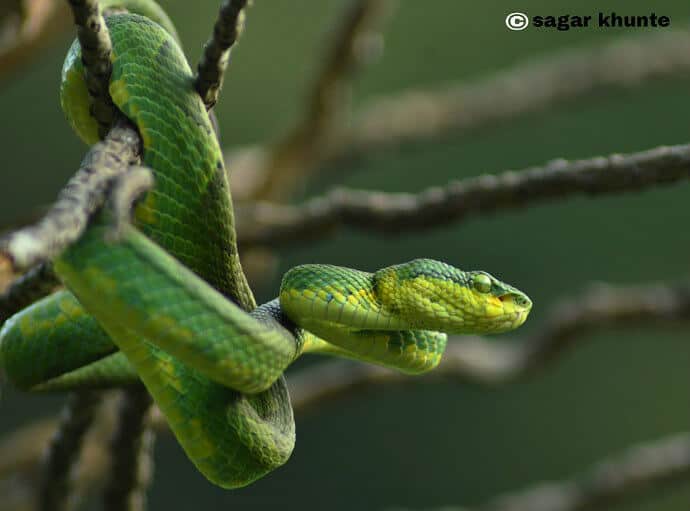
Indian Light-green Pit Viper
Known by many other names (such as the Bamboo Pit Viper, Dark-green Tree Viper, and Bamboo Ophidian), the Indian Green Pit Viper can be plant in southern Indian jungles.
These snakes are named for their vivid green color, which helps camouflage them from predators in the forest.
The fangs on these snakes are a unique feature: They are hollow and tin grow back if they fall out.
These snakes live high in the copse and chase at night, feeding on birds, lizards, and occasionally rodents. They often adopt to residuum in the shade of bamboo and other thick trees rather than forth the water.
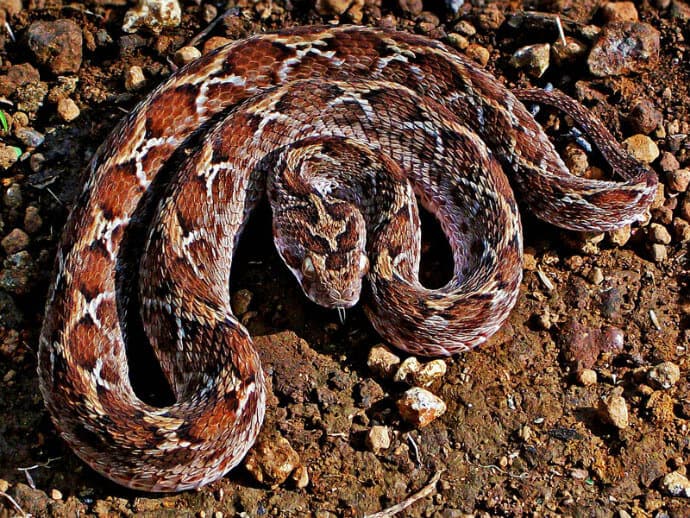
Saw Scaled Viper
The Saw-scaled Viper is named for its unusual scales, which are arranged in uneven rows all over its body.
They are smaller than many other venomous snakes, but are known for having quite a temper. When they're angry, these snakes move slowly: Their uneven scales rub against each other to produce a hissing dissonance, which becomes louder the angrier they get.
There are 8 species of Saw-scaled Vipers, and some of these are the crusade for the most deaths by snake bites globally.
These mortiferous snakes are primarily constitute in north Bharat, feeding on a wide diversity of prey ranging from insects to minor reptiles.
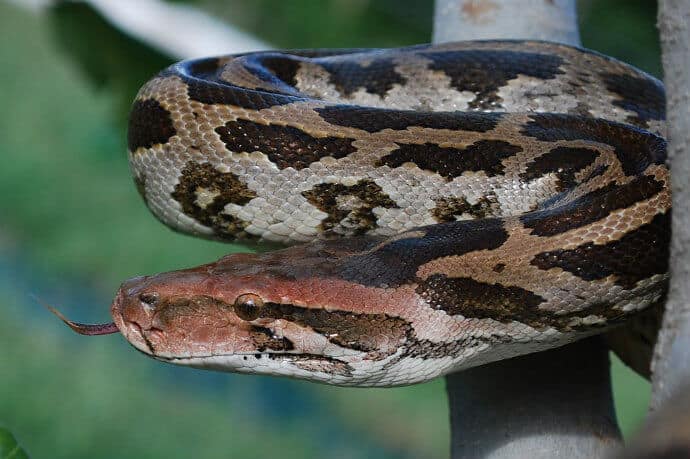
Indian Rock Python
Like other pythons, the Indian Python is a constrictor that wraps around and squeezes its casualty rather than biting them or injecting them with venom.
With a lite dark-green color, these snakes live alone in the forest, hanging on tree branches during the day and hunting at night. But they tin adapt to many other environments besides, as long as h2o is nearby.
They usually casualty on minor mammals, reptiles, and birds, constricting them and swallowing them whole. Only they have a special preference for rodents.
This method of eating allows these large snakes to abstain from eating for weeks on end.
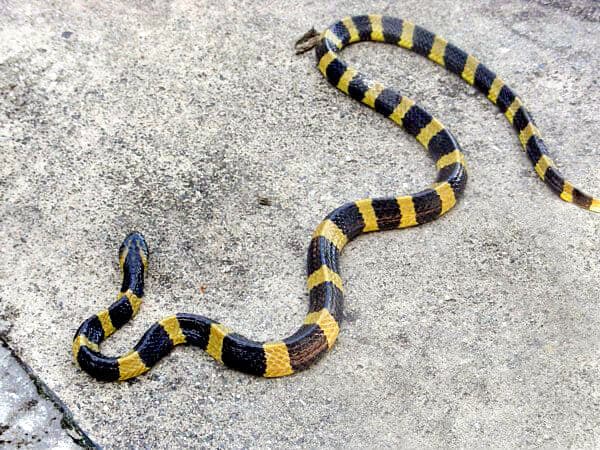
Kraits
Small, but incredibly deadly, Kraits are the most highly venomous snakes in India.
The boilerplate krait is only three feet long, but their bites tin quickly crusade respiratory failure and decease for their victims.
They hunt at night, their prey beingness other snakes as well as reptiles and pocket-sized mammals.
Kraits come in several dissimilar varieties. The Common Krait is about inactive during the day, but bites its prey at nighttime, ultimately causing paralysis.
Some species can be found in water as well as on state. Ocean Kraits feed on eels and other fish, and their venom is incredibly potent also.
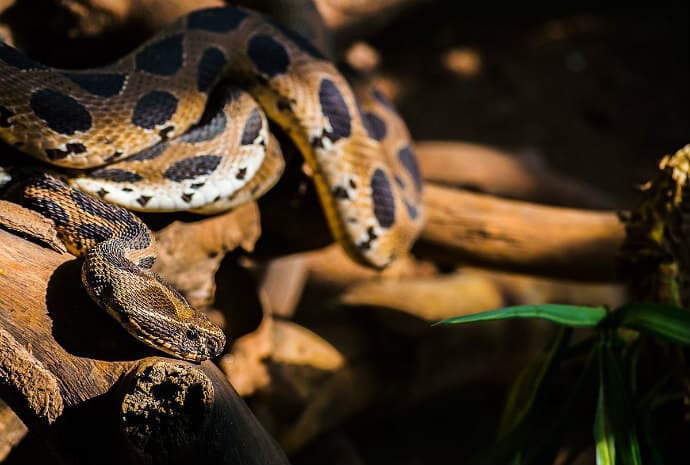
Russell'south Viper
Rounding out the big four of Republic of india's most dangerous snakes, Russell'south Viper is very ambitious and responsible for many snake bites in populated areas.
Named for Scottish herpetologist Patrick Russell, these snakes are four feet long on boilerplate, with a dark brown body and lighter brown spots.
These snakes are unremarkably found in open up areas feeding on pocket-size mammals, birds, and reptiles, but are sometimes seen in human-populated areas when hunting for food.
Bites from these snakes tin lead to immense pain and maybe kidney failure. Luckily, adult snakes do not move very fast unless provoked, so they are best left alone.

Red Sand Boa
Institute throughout Bharat, the Red Sand Boa is like shooting fish in a barrel to identify past its dark cherry-red color. These nocturnal snakes live in agricultural or desert areas, where they feed on rodents and other snakes past using constriction.
These snakes are non-poisonous, merely they are ofttimes traded illegally due to perceived beliefs of bringing good luck and curing diseases.
Function of this conventionalities comes from the presence of "two heads:" ane beingness the actual head and the other being the tail, which greatly resembles a caput.
These snakes are likewise endangered considering they are dug out of the footing, where they tend to reside, past farmers.
INDIAN LIZARDS
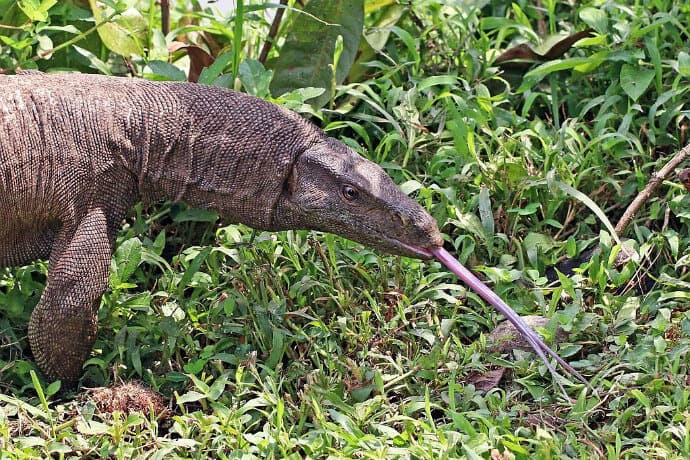
Bengal Monitor Lizard
Spending well-nigh of their days searching for nutrient, Bengal Monitor Lizards are constitute in various habitats throughout Republic of india.
Unlike like lizard species, Bengal Monitors are more adaptable to different climates and tin live in areas with both high and low levels of precipitation.
Their tongues resemble those of snakes, with a fork in the eye that helps them observe food. Their prey ranges from modest mammals and birds to other reptiles.
Bengal Monitor Lizards are as well uncommonly strong. They tend to burrow in the ground when escaping predators. To go along safe, they fill their lungs with air and dig their claws into the hiding space, making them nigh impossible to dislodge.

Indian Chameleon
The Indian Chameleon is similar to other chameleons in its physical characteristics.
Like monkeys, they take prehensile tails that help them balance and comfortably stay up in the copse. Like other chameleons, the Indian variety changes color for communication purposes.
Their large eyes can motility in separate directions of each other, giving these lizards a broad range of vision.
Indian Chameleons are typically green or brown in color. Their colour-changing power is due to the presence of pigment granules found in some of their cells that respond to the chameleons' emotions and environment, not to match their current groundwork.
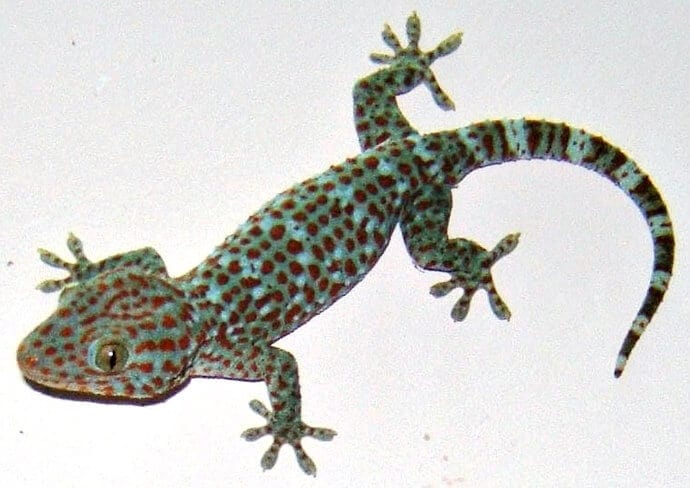
Indian Gecko
The Indian Gecko, also known equally the Tokay Gecko, can be found in rainforest environments.
These Indian lizards are 1 of the largest species of gecko, and are identified by their bright blue-gray bodies covered with red and yellow spots.
These geckos stand out for their noticeable adaptations: Their large optics accept clear scales over them that act like lenses, and their strong jaws and teeth can requite a nasty seize with teeth that, thankfully, is not venomous.
These nocturnal lizards can be found eating insects equally well equally other geckos, and are commonly alone. If you see one, exist cautious, as they tin can be territorial when confronted by people.
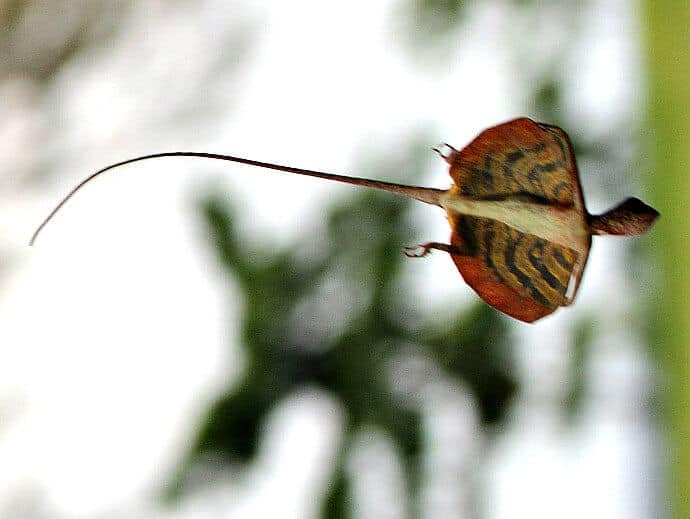
Dragon Lizards (Fan-Throated and Southern Flight)
India is home to Dragon Lizards of diverse shapes and sizes.
The Fan-Throated Dragon Lizard is named for the layer of skin beneath its chin, which resembles a fan. This lizard tin can exist establish all over Bharat, living forth the forest floor.
At that place were five known species of Fan-Throated Lizard, but in 2016 a new species was discovered. Information technology was named for British naturalist and broadcaster Sir David Attenborough.
Another aptly-named lizard is the Southern Flying Dragon Cadger, or Draco Cadger. Though they technically practice not have wings, the long ribs and tails of these lizards extend and allow them to "fly" in lodge to avoid predators.
READ MORE: Meridian 5 Things to exercise in Indonesia

Spiny Tailed Cadger
Institute in northern Africa as well every bit India, the Spiny-tailed Lizard can handle the rut. Too known every bit the Dab Lizard, this reptile is vegetarian and feeds on plants found in their habitats.
Their scientific proper name, uromastyx, is Greek for "tail," and their tail is a very of import physical feature.
Their common name comes from the spines that grow all forth their tails, which can be used to defend themselves against predators.
Spiny-tailed Lizards slumber with their powerful tails facing the entrance to their dens in order to protect themselves.
Another useful accommodation is their yellow-chocolate-brown coloring with black spots, which helps camouflage them against rocks.
READ MORE: thirty Amazing Galapagos Isle Animals
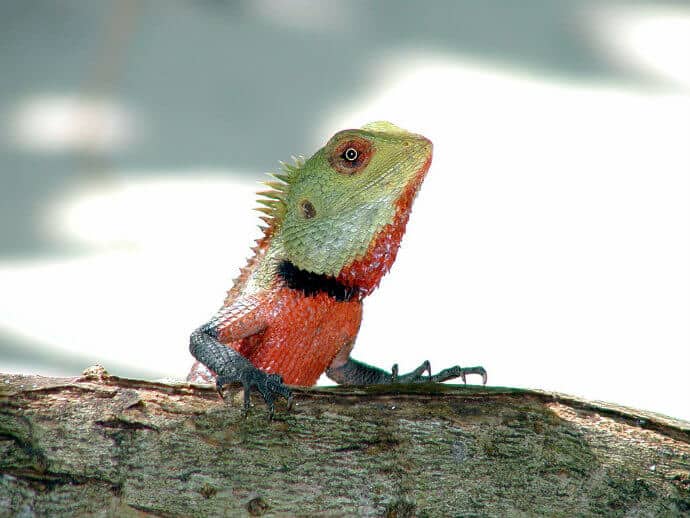
Oriental Garden Lizard
Plant in forests, the Oriental Garden Cadger is also known by several other names. It is sometimes known as "Bloodsucker," nearly likely considering males take blood-red heads and necks when mating.
They are likewise chosen calotes, and come in a variety of colors ranging from orangish to majestic.
Other names for the cadger include Eastern Garden Lizard and Changeable Cadger, which is fitting considering their wide range of coloring.
These lizards feed on insects, and when they bite they do not draw blood. Along with insects, they feed on rodents and other lizards, swallowing their prey whole like some snakes practice.
OTHER INDIAN REPTILES
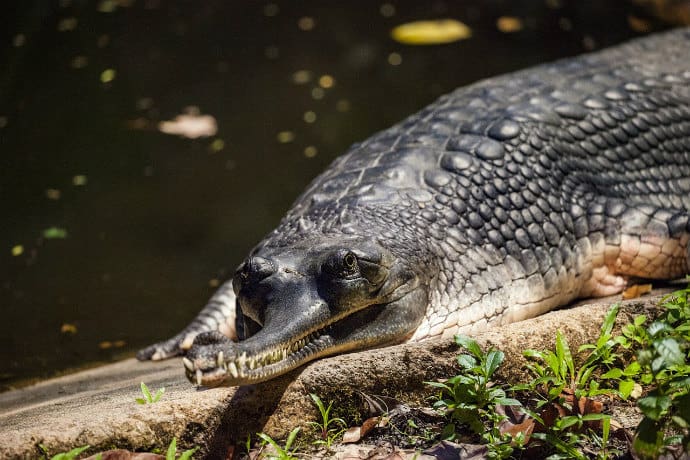
Crocodiles (Gharial, Mugger, Saltwater)
India is dwelling to several dissimilar species of crocodiles, and some are more unsafe than others.
The Mugger Crocodile has a characteristic flat nose and is one of the largest crocodile species. Although it feeds on Indian reptiles and fish, this massive croc has also attacked and killed large mammals and people.
The Gharial, another of the more endangered species of Indian wild fauna, is establish in northern Indian rivers. It does not target people, but uses its precipitous teeth to feed on fish and human corpses institute in the water.
Southern India is home to the Saltwater Crocodile, which, ironically, can be found in freshwater likewise,. It tin weigh over 1,000 pounds and can also be dangerous to humans.

Olive Ridley Sea Turtle
With an olive-green skin and shell color, the Olive Ridley Sea Turtle is found in the warm waters of the Indian Body of water.
These turtles are some of the smallest body of water turtles in the world, and only weigh up to 100 lbs.
Some of these turtles are solitary, while others nest in large groups called arribadas. It is unclear to researchers why their nesting patterns vary and so greatly.
Located in the eastern Indian city of Odisha, Gahirmatha Turtle Sanctuary is one of the earth'southward largest nesting sites for the Olive Ridley.
This area became a sanctuary in 1997, and attracts thousands of turtles during the almanac mating flavour, which lasts from Oct through May. –by Anika Chaturvedi; intro by Bret Honey
Source: https://greenglobaltravel.com/indian-animals-indian-wildlife-species/
Posted by: hollynuied1984.blogspot.com

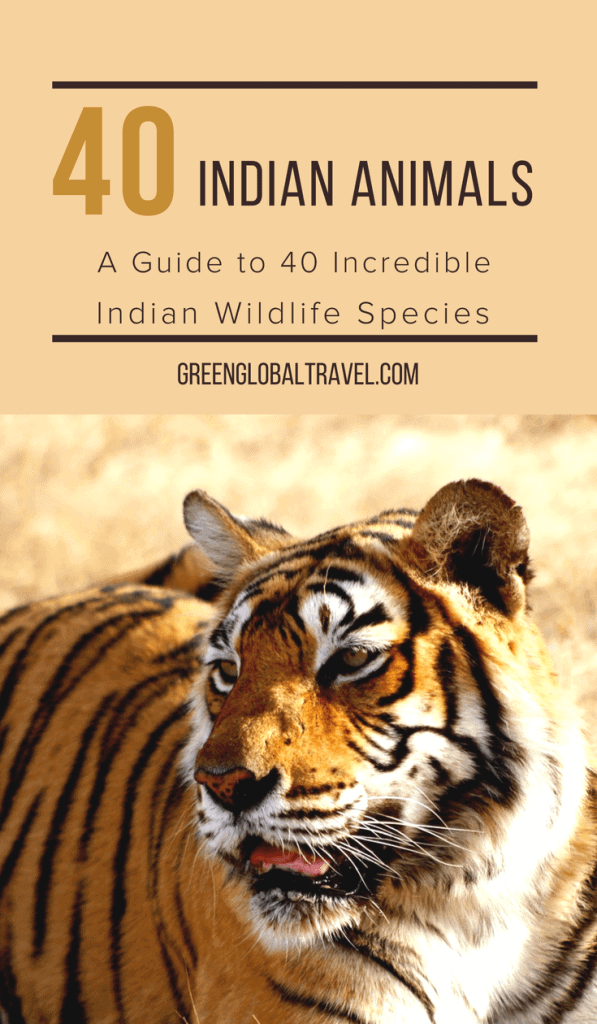

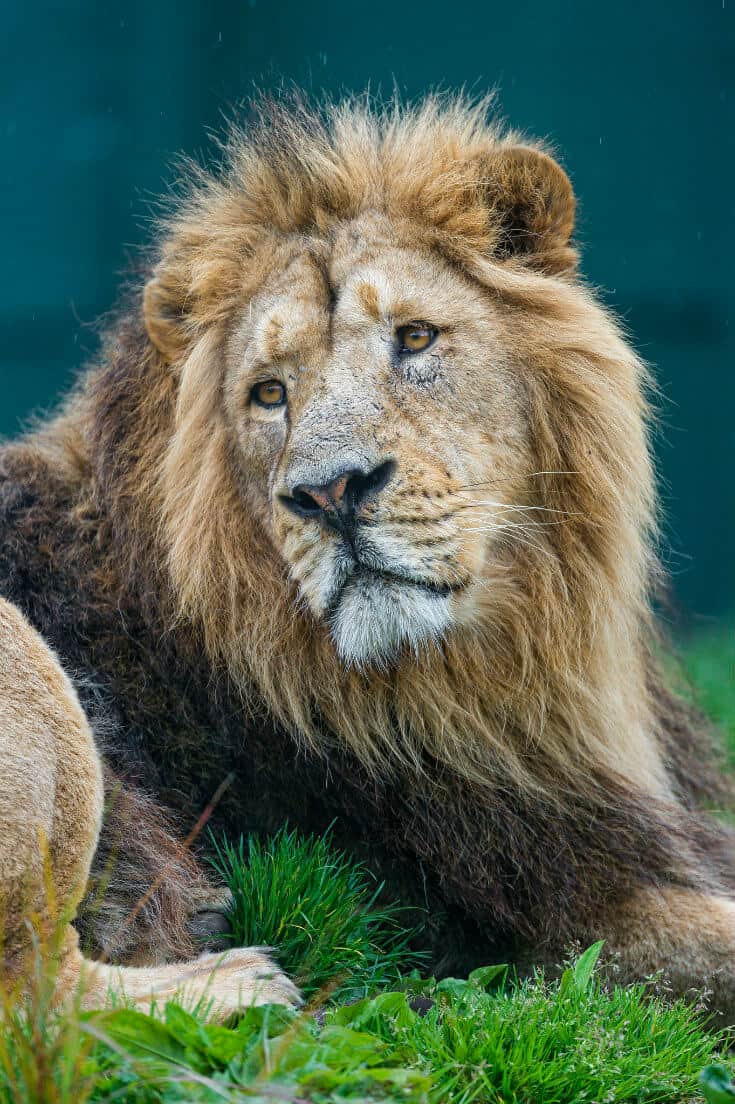
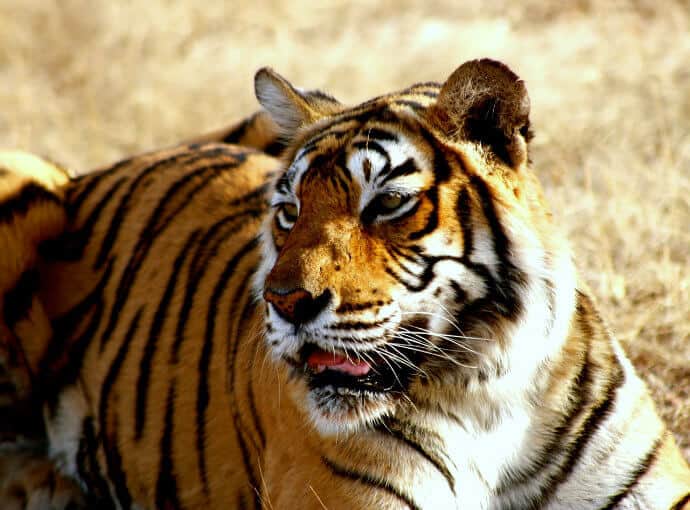
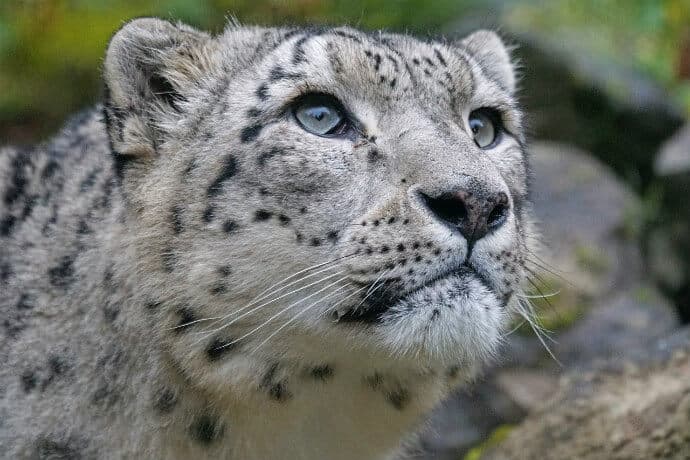


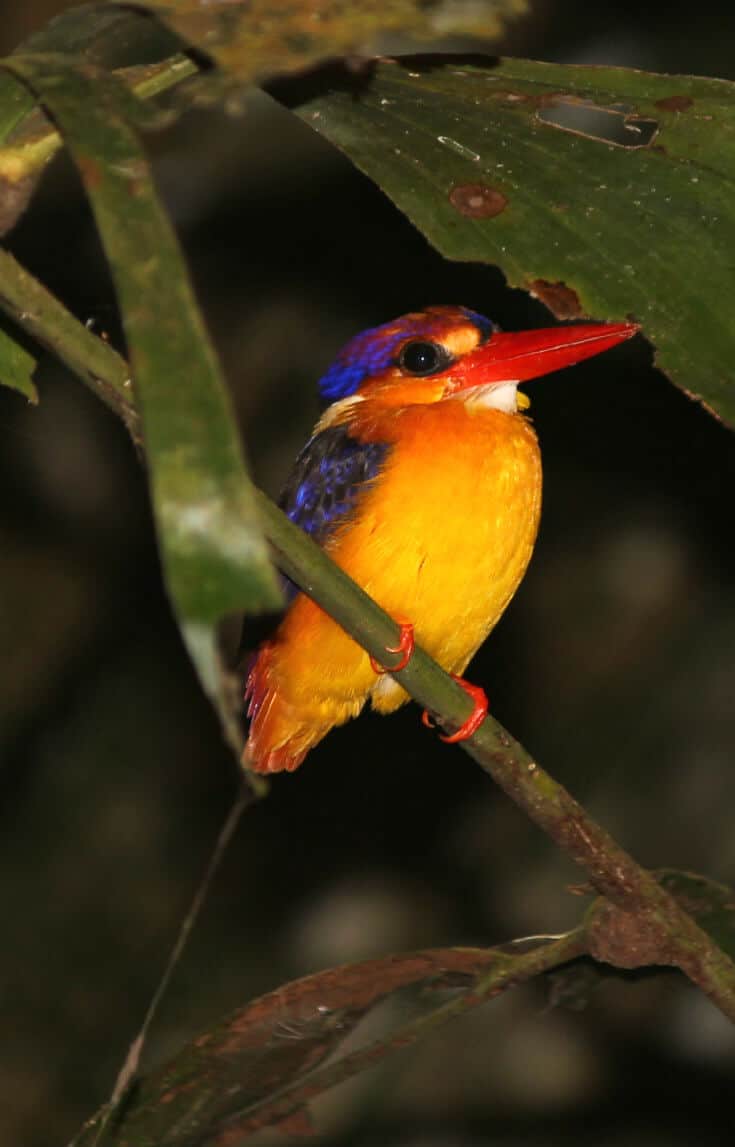
0 Response to "What Types Of Water Plants And Animals Found In The Indian Ocean"
Post a Comment